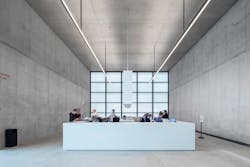The James Simon Gallery is the new entrance building for Berlin’s Museum Island. From August 2019, it will serve as the point of entry for visitors from all over the world. But it wouldn’t be fair to reduce this streamlined, graceful building to a simply functional entity. In both architectural and practical terms, the building by David Chipperfield Architects Berlin connects the ensemble of museums on the Island. It offers the general public a wonderful area in which to stroll and linger. Zumtobel was lighting partner throughout the planning and construction phases, which lasted for many years, developing a lighting concept especially for the building.
It’s an effective gesture of welcome – the flight of wide steps leading to the James Simon Gallery is an architectural invitation to visit Berlin’s Museum Island and discover the great works of art it holds. The new visitor centre is named after entrepreneur and patron of the arts, James Simon (1851–1932). The Staatliche Museen zu Berlin (“National Museums in Berlin”) have him to thank for many valuable works, including the world-famous Nefertiti Bust and the Ishtar Gate.
The James Simon Gallery creates a direct aboveground connection to the Pergamon Museum and connects it in turn via the Archaeological Promenade to the Neues Museum (“New Museum”), the Altes Museum (“Old Museum”) and the Bode Museum. The flight of steps outside the gallery brings visitors to the building’s spacious foyer, where they can buy their tickets, enjoy the view from the terrace and relax in the café. The lower floors house space for temporary exhibitions, the auditorium, the museum shop and the cloakroom.
Some areas of the James Simon Gallery will also be accessible outside of the opening times, increasing the number of public spaces on the Museum Island. The spacious architectural language creates a smooth transition between the interior and exterior. Elements such as skylights, colonnades and flights of steps combine to create a building “that celebrates the accessibility of the museums and the art works that they house – and encourages people to take their time as they move through it”, as Alexander Schwarz, partner at David Chipperfield Architects Berlin and the project’s design director, describes the concept. The architects paid homage to some of the other architects who have defined the Museum Island, including Karl Friedrich Schinkel and Friedrich August Stüler, and, at the same time, brought the building right into the twenty-first century, by using contemporary materials such as glass, concrete and natural stone, for example.
One of the main aims of the lighting plan was to provide the open architectural structure, which gets plenty of daylight, with optimal artificial light. In addition, it meant bundling all the building services in a single channel, so they were invisible to visitors, in order to emphasise the building’s distinct structure. Zumtobel used this brief to develop the appropriate light and media channels, which run through the concrete ceiling of the whole building and integrate both loudspeakers and sprinkler systems. The indirect lighting enhances the natural daylight throughout the day, wherever needed, and also enables the visitor centre to be lit discreetly from the inside when it’s dark.
To make the room and exhibit lighting in the auditorium and exhibition areas as flexible as possible, Zumtobel selected luminaires including CIELUMA and ARCOS. The CIELUMA ceiling luminaires consist of square textile light modules, with the gentle progression of the light from the edge to the middle of the luminaire a particularly noteworthy feature. A colour temperature of 3800 K ensures pleasant, uniform basic lighting in the room. CIELUMA offers visitors another advantage, too – the acoustic fabric absorbs sound, reducing unwanted ambient noise in the room – so that they can enjoy the art, uninterrupted. The ARCOS LED spotlights’ role is to showcase the exhibits. The spotlights provide accented lighting for the exhibits, high colour rendering (Ra > 90) and excellent light quality. The UV- and IR-free light also protects the delicate artworks, while thanks to tunableWhite technology, the colour temperature can be adjusted to suit each individual exhibit. It’s a great example of colours and materials working together perfectly.
Zumtobel developed another special luminaire for the second floor of the James Simon Gallery. The CRAFT high-bay luminaire, whose light provides both broad and precise illumination, was mounted in a light cube of thin marble panels. The result: pleasant lighting and a real eye-catcher!
When planning the lighting for the James Simon Gallery, Zumtobel had to overcome very particular challenges. The rate at which LED lighting technology develops is about as fast as the planning and construction phases for a museum building are slow. This meant constantly updating the lighting planning and adapting it flexibly. “When it comes to lighting in architectural structures, it’s crucial to test how it’s perceived in reality and then adapt the technology to it”, says architect Alexander Schwarz. “During this discussion process, and the process of trial and error in the actual building, Zumtobel was always open and very professional,” continues Schwarz, describing the collaboration with the Austrian luminaire manufacturer. The James Simon Gallery isn’t the only project on which Zumtobel and David Chipperfield Architects have collaborated: David Chipperfield developed the ARCOS museum spotlight for Zumtobel and designed the Zumtobel Group’s 2012/2013 annual report.
Contact:
Zumtobel Lighting GmbH
Schweizer Strasse 30A-6851 Dornbirn
Tel: + 43 5572 390-0





